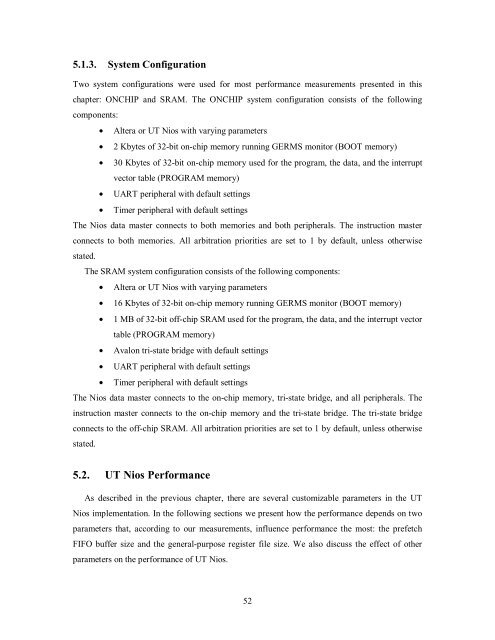Soft-Core Processor Design - CiteSeer
Soft-Core Processor Design - CiteSeer
Soft-Core Processor Design - CiteSeer
Create successful ePaper yourself
Turn your PDF publications into a flip-book with our unique Google optimized e-Paper software.
5.1.3. System Configuration<br />
Two system configurations were used for most performance measurements presented in this<br />
chapter: ONCHIP and SRAM. The ONCHIP system configuration consists of the following<br />
components:<br />
• Altera or UT Nios with varying parameters<br />
• 2 Kbytes of 32-bit on-chip memory running GERMS monitor (BOOT memory)<br />
• 30 Kbytes of 32-bit on-chip memory used for the program, the data, and the interrupt<br />
vector table (PROGRAM memory)<br />
• UART peripheral with default settings<br />
• Timer peripheral with default settings<br />
The Nios data master connects to both memories and both peripherals. The instruction master<br />
connects to both memories. All arbitration priorities are set to 1 by default, unless otherwise<br />
stated.<br />
The SRAM system configuration consists of the following components:<br />
• Altera or UT Nios with varying parameters<br />
• 16 Kbytes of 32-bit on-chip memory running GERMS monitor (BOOT memory)<br />
• 1 MB of 32-bit off-chip SRAM used for the program, the data, and the interrupt vector<br />
table (PROGRAM memory)<br />
• Avalon tri-state bridge with default settings<br />
• UART peripheral with default settings<br />
• Timer peripheral with default settings<br />
The Nios data master connects to the on-chip memory, tri-state bridge, and all peripherals. The<br />
instruction master connects to the on-chip memory and the tri-state bridge. The tri-state bridge<br />
connects to the off-chip SRAM. All arbitration priorities are set to 1 by default, unless otherwise<br />
stated.<br />
5.2. UT Nios Performance<br />
As described in the previous chapter, there are several customizable parameters in the UT<br />
Nios implementation. In the following sections we present how the performance depends on two<br />
parameters that, according to our measurements, influence performance the most: the prefetch<br />
FIFO buffer size and the general-purpose register file size. We also discuss the effect of other<br />
parameters on the performance of UT Nios.<br />
52














